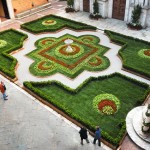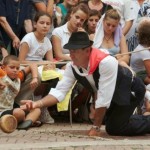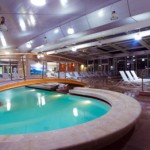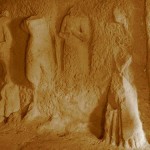Jun
Itineraries
Montepulciano
This marvellous city is called the pearl of XVI century for its artistic and architectural characteristics, which today are still maintained. Climbing the steep alleys visitors will discover beautiful palaces and churches, where the most famous architects of Renaissance transported their incomparable art. The glorious Piazza Grande is remarkable with the Dom characterized by an unfinished façade and a town hall.
In the valley below, in an unforgettable landscape, the elegant building of San Biagio catches the eyes.
Montepulciano is also seat of a lively and cultural activity: one of the most important shows of Cantiere Intrenazionale d’Arte is the popular show of Bruscello. During the summer a show with a medieval character takes place: the Bravio delle Botti. During this particular race each district takes part in the run rolling barriques towards the higher point of the town. Montepulciano is well-known as wine centre. Around its hill flourishing and ancient vineyard extent. In the centre it is possible to find wineries of the most famous producer as well as small and characteristic shops.
Pienza
At the beginning of its history it was Castle of Corsignano, but it took the actual name from Pope Pius II Piccolomini, who promoted, in the second half of XV century, the reconstruction and the project to make this town the utopian and ideal city of the Renaissance.
The entire village is a remarkable jewel, particularly the Dom with the art works of Giovanni di Paolo, Matteo di Giovanni Del Vecchietta and Sano di Pietro; in the interior there is also a marble altar attributed to Rossellino, the architect who got the commission to redesign the city.
Near the Dom there is the Diocesan museum, where it is possible to admire works of the school of Sodoma and of Sano di Pietro, Fleming tapestries of XVI and XVII century. Near the beautiful Palazzo Piccolomini, built under the project of Bronzino e Beccafumi. In the valley there is the enchanting Cultural Natural Artistic Park of Val d’Orcia with gullies, undulating grounds and the famous Crete.
Cortona
The information about this city are several but inexact and sometimes contradictory. About its origin we have charming legends. It is told that Noah’s son, Crano found it. That would be the explanation of the habitants’ name of the area, called at this time Imbri or Umbri, descending from Noah, who was saved from water “ab imbribus”. From Cano’s breed was born Dardano, who escaped in Greek and found Troy. According to Virgil his descent came back to Italy, where in Latium found Rome.
On the basis of this tradition from Cortona comes Troy and Rome. The modern historiography seems to agree that Cortona has an Umbrian origin and then conquered and made magnificent by Etruscan people. A proof of its power is the length of the walls and the discoveries in the graves of its Principes, which shows a flourish activity and an own money.
To visit Cortona means meeting the past. Here it is possible to admire great examples of medieval tower or building of XIV century (via Ghibellina and Iannelli), several convents near the church and ancient palaces which are symbol of power and aristocracy from XVI century. It is impossible to forget the place of the community like the Town Council Hall, the Palazzo del Capitano del Popolo and Signorelli Theatre built in XIX century which adorns the main square. It worth remembering the most beautiful churches: San Francesco, the Dom, Santa Maria delle Grazie al Calcinaio (at the foot of the city) and the charming Sanctuary of Santa Magherita , not far from which raises the ancient fortress of Girifalco.
Arezzo
The discovery of the Olmo skull (a human skull of 50.000 years ago) is a proof that the Aretinian area was inhabited in ancient time. Aretium was the city name with an uncertain origin and meaning, but considered of Etruscan origin Several time it was cited by Latin and Greek authors. During the Etruscan period the city was one of the twelve confederate “lucomonie” of Etruria, that occupied the actual geographical area of Aretinian region. In this period the city knew a great development halted in the roman period. The diffusion of Christian religion created social contrasts and was the incentive to build a religious centre out of the city wall (Pionta). This division between city and religious life was smoothed away during the Municipal period, when an economical cultural and artistic development took place giving the city the actual aspect. In this period were built towers and magnificent houses, the platea communis (Piazza Grange) was restored and the most important religious and civic buildings were built: the church of Santa Maria, the Dom, San Domenco, San Francesco, the Town Hall and the Palazzo dei Priori.
OToday Arezzo is world-wide known as the gold city thanks to the flourish goldsmith industry exploded in the ’50s and ’60s, in an area where the goldsmith art was traditional.
- Church of Santa Maria: It was built between IX and XI century, rebuild and restored in XII and XIII century. It constitutes the most suggestive medieval monument of Aretinian area. Its original façade has a particular bell tower, called Campanile delle Cento Buche (of the Hundreds Holes) because of its several mullion windows. It worth to be admired a bas-relief of an unknown artist of XIII century situated in the archivolt and representing the 12 months throw the typical activities of the year. The apse and the south side are remade in XIX century.
- Piazza Grande: One time it was used as open market out of walls, but the square was restored in XIII century after building the sixth city walls. Today it is considered one of the most beautiful Italian square with its trapezoidal design and its about 10 metres of difference in level. On the west side, near the apse, raises the Tribunal Palace and on its side it is possible to admire one of the masterpieces of the Renaissance architecture in Arezzo, the Palace of Fraternita dei Laici. This square side maintains a Romanesque style, although it was hardly restored in XIX century. On the south side we can see the XV century Palazzo Cofani-Brizzolari; on the east side can still watch the typical medieval houses; on the north side the magnificent Palazzo delle Logge built in XVI century in order to close the square. This place was previously occupied by tow buildings (Palazzo della Torre Rossa and of the Capitano Del Popolo) demolished by Cosimo I of Medici. In Piazza Grande, during the first weekend of each month, the Fair of Antiquity takes place. This appointment is the third one for visitors and importance in Europe. Twice a year (on the firs Sunday of September and on the night of the last Sunday of June) in the same square, it is possible to assist at the Giostra Del Saracino, a show of a medieval character, rediscovered in ’30s.
- Dom: Coming from the centre the bell tower spire of this majestic Dom catches the eyes beside the walls and the buildings. The works begun in the earl XIII century and continued at the beginning XIV century. A considerable bequest of pope Gregorio X permitted to build it and the project begun when the religious centre was included in the city leaving the Pionta area. During the following centuries the Don was modified with exterior additions.









